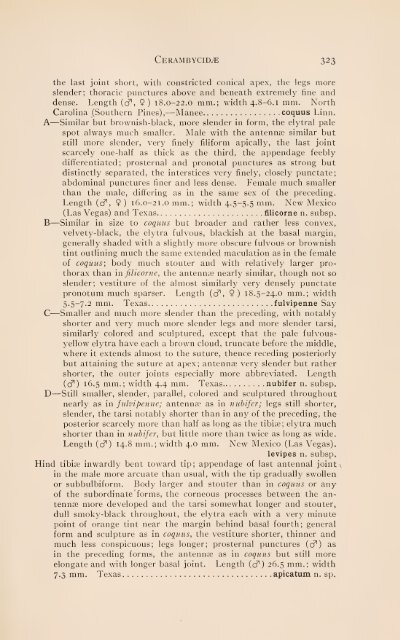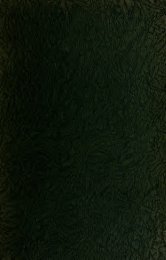Memoirs on the coleoptera
Memoirs on the coleoptera
Memoirs on the coleoptera
You also want an ePaper? Increase the reach of your titles
YUMPU automatically turns print PDFs into web optimized ePapers that Google loves.
CERAMBYCID^E 323<br />
<strong>the</strong> last joint short, with c<strong>on</strong>stricted c<strong>on</strong>ical apex, <strong>the</strong> legs more<br />
slender; thoracic punctures above and beneath extremely fine and<br />
dense. Length (cf, 9) 18.0-22.0 mm.; width 4.8-6.1 mm. North<br />
Carolina (Sou<strong>the</strong>rn Pines), Manee coquus Linn.<br />
A Similar but brownish-black, more slender in form, <strong>the</strong> elytral pale<br />
spot always much smaller. Male with <strong>the</strong> antennae similar but<br />
still more slender, very finely filiform apically, <strong>the</strong> last joint<br />
scarcely <strong>on</strong>e-half as thick as <strong>the</strong> third, <strong>the</strong> appendage feebly<br />
differentiated; prosternal and pr<strong>on</strong>otal punctures as str<strong>on</strong>g but<br />
distinctly separated, <strong>the</strong> interstices very finely, closely punctate;<br />
abdominal punctures finer and less dense. Female much smaller<br />
than <strong>the</strong> male, differing as in <strong>the</strong> same sex of <strong>the</strong> preceding.<br />
Length (cf, 9) 16.0-21.0 mm.; width 4.5-5.5 mm. New Mexico<br />
(Las Vegas) and Texas filicorne n. subsp.<br />
B Similar in size to coquus but broader and ra<strong>the</strong>r less c<strong>on</strong>vex,<br />
velvety-black, <strong>the</strong> elytra fulvous, blackish at <strong>the</strong> basal margin,<br />
generally shaded with a slightly more obscure fulvous or brownish<br />
tint outlining much <strong>the</strong> same extended maculati<strong>on</strong> as in <strong>the</strong> female<br />
of coquus; body much stouter and with relatively larger prothorax<br />
than in filicorne, <strong>the</strong> antennae nearly similar, though not so<br />
slender; vestiture of <strong>the</strong> almost similarly very densely punctate<br />
pr<strong>on</strong>otum much sparser. Length (cf, 9) 18.5-24.0 mm.; width<br />
5.5-7.2 mm. Texas fulvipenne Say<br />
C Smaller and much more slender than <strong>the</strong> preceding, with notably<br />
shorter and very much more slender legs and more slender tarsi,<br />
similarly colored and sculptured, except that <strong>the</strong> pale fulvousyellow<br />
elytra have each a brown cloud, truncate before <strong>the</strong> middle,<br />
where it extends almost to <strong>the</strong> suture, <strong>the</strong>nce receding posteriorly<br />
but attaining <strong>the</strong> suture at apex; antennae very slender but ra<strong>the</strong>r<br />
shorter, <strong>the</strong> outer joints especially more abbreviated. Length<br />
(cf ) 16.5 mm.; width 4.4 mm. Texas nubifer n. subsp.<br />
D Still smaller, slender, parallel, colored and sculptured throughout<br />
nearly as in fulvipenne; antennae as in nubifer; legs still shorter,<br />
slender, <strong>the</strong> tarsi notably shorter than in any of <strong>the</strong> preceding, <strong>the</strong><br />
posterior scarcely more than half as l<strong>on</strong>g as <strong>the</strong> tibiae; elytra much<br />
shorter than in nubifer, but little more than twice as l<strong>on</strong>g as wide.<br />
Length (cf) 14.8 mm.; width 4.0 mm. New Mexico (Las Vegas).<br />
levipes n. subsp.<br />
Hind tibiae inwardly bent toward tip; appendage of last antennal joint \<br />
in <strong>the</strong> male more arcuate than usual, with <strong>the</strong> tip gradually swollen<br />
or subbulbiform. Body larger and stouter than in coquus or any<br />
of <strong>the</strong> subordinate forms, <strong>the</strong> corneous processes between <strong>the</strong> an-<br />
tennae more developed and <strong>the</strong> tarsi somewhat l<strong>on</strong>ger and stouter,<br />
dull smoky-black throughout, <strong>the</strong> elytra each with a very minute<br />
point of orange tint near <strong>the</strong> margin behind basal fourth; general<br />
form and sculpture as in coquus, <strong>the</strong> vestiture shorter, thinner and<br />
as<br />
much less c<strong>on</strong>spicuous; legs l<strong>on</strong>ger; prosternal punctures (cf 1<br />
)<br />
in <strong>the</strong> preceding forms, <strong>the</strong> antennae as in coquus but still more<br />
el<strong>on</strong>gate and with l<strong>on</strong>ger basal joint. Length (cf ) 26.5 mm.; width<br />
7.3 mm. Texas apicatum n. sp.



